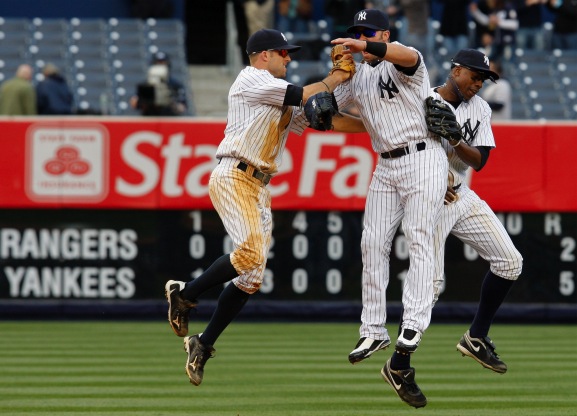
Just how good is the Yankees outfield defense? The eye test paints a pretty picture, and the numbers provide a similar perspective. This morning Stephen cited a Dan Barbarisi post that further examines the defensive numbers for the Yankees’ outfield, and the returns are predictably good. As a unit the Yankees outfielders have a UZR of 20.1, or 8.7 per 150, which ranks third in all of baseball. Only Arizona and Boston lead them. The major difference among the three teams is how they accumulate these defensive numbers. Both Arizona and Boston accomplish this with range; their 37.3 and 22.8 range runs lead the league by a decently wide margin. While the Yankees do have quality range numbers, they have something that the Red Sox and Diamondbacks do not: quality outfield arms.
As a unit the Yankees’ outfielders have produced 4.4 runs above average with their arms. That ranks seventh in baseball, and just 0.3 points away from fourth. All three of the starters not only have positive arm scores this year, but all three rank in the top 20 among all MLB outfielders in arm score. Again, this passes the eyeball test at least as it concerns 2011. They’ve all had issues in the past, but it does appear that they’ve turned it around. In 2011 they’re apparently turning the corner.
Before we proceed, a word about the small sample that is the 2011 season. It is absolutely true that to gain any value from defensive metrics you need heaps of data — preferably three years’ worth. Clearly we’re not getting anything close to that by examining year-to-year improvements for each player. Yet I’m confident that we’re measuring something real — that is, something that actually happened on the field — when we’re looking at arm scores. From the FanGraphs UZR primer, arm scores are “based on the speed and location of batted balls to the outfield and how often base runners advance extra bases (advances), don’t advance the extra base (holds), or get thrown out trying to advance (kills).” While speed and location are subject to bias, the play-by-play data can give us a good idea when it comes to advances, holds, and kills. So while there is a level of noise in these data, there is also some truth, stemming from the “it happened” factor.
Since he arrived in New York, it was apparent that Nick Swisher had an arm more suited for a left fielder, or even a DH. He lollipopped throws with consistence in 2009, and the numbers bore it out; he had a -5.9 arm score, which was tied with Brad Hawpe for worst in the majors. The problems were so bad that he went to then pitching coach Dave Eiland for advice on how to better hurl a baseball. That seemingly did the trick. In 2010 he improved to -0.8 arm runs above average. This year he’s at 1.6 runs above average, which ranks 19th among MLB outfielders.
While Gardner occasionally uncorked a five-bouncer to home plate during his first two years in the outfield, he still produced generally good arm numbers. From 2008 through 2009 they went: 5.0, 2.4, 6.6. The score in 2008 and the huge jump in 2010 might have been a product of perception. Gardner doesn’t look like a guy with a quality arm, therefore coaches and base runners might be more apt to attempt the extra base. To wit, he had 12 assists last year, which ranked second among MLB outfielders. This year he has only six assists, perhaps because the league has adapted to his actual arm skill. Despite that he still has an arm score of 1.7, which ranks 15th among MLB outfielders. It suggests that he’s holding base runners, rather than killing them.
That leaves Granderson, who had mixed results in terms of arm score earlier in his career. He was actually below average in his final two years with the Tigers, but has been positive in both of his seasons with the Yankees. In fact, his 1.9 arm score from this year ranks 10th in baseball. This is due, in large part, to his eight outfield assists, which ranks 15th among outfielders. The only other year in which he’s had more than five assists was in 2007, when his arm score was at a career high 4.1. I want to say that Granderson’s arm score stems from the same bias that Gardner’s does: teams using old and unreliable information concerning Granderson. But I’m not sure there’s enough evidence there to render that any more credible than any other pet theory.
On broadcasts this season the Yankees crew has often mentioned that the outfielders, not just Swisher, have worked with Larry Rothschild on their throwing. It makes perfect sense, of course, since outfielders want to generate power with their throws just as pitchers do. While it’s an anecdote, it apparently shows up in the data as well. Whatever the case, the Yankees starting outfield is not only doing an excellent job of running down fly balls, but they’re also holding and killing base runners with efficiency. After years and years of watching one of the poorest outfield defenses in the league, it’s nice to finally see the Yankees on top.
Leave a Reply
You must be logged in to post a comment.